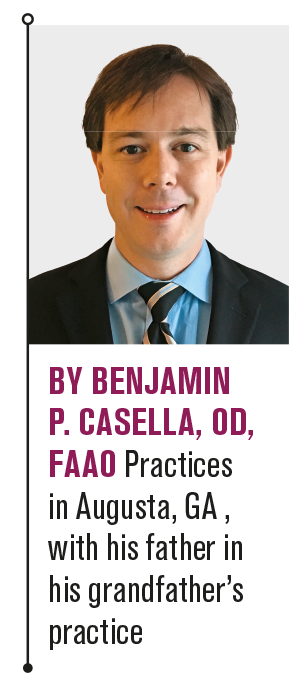How I handled an unusual contact lens request
Corneal scars in a soft contact lens wearer indicating previous complications.


There truly is an art to prescribing. This statement, in my opinion, holds more truth with respect to the prescribing of contact lenses than anything other aspect of my clinical life.
With that said, let me submit, for your thoughts-and advice-a clinical vignette which took place at my home not long ago.
Request from a friend
I was out in the yard taking the Christmas lights out of our Japanese maple because, frankly, it was early March. A friend of the family walked by and presented me with a thought-provoking request which I hadn’t heard before.
Her son is going to climb Mount Kilimanjaro this summer, and he is a moderate myope. I have seen him as a patient for some years, and he wears soft disposable contact lenses. In the assessment and plan section of his eye exams, there is always “DWO” typed within the section on contact lens wear. It stands for “daily wear only” because I do not recommend to any of my patients to sleep in their contact lenses.

Related: Video: How daily disposables help a rough travel day
Contact lens wear, in general, is not without risk. Overnight wear has been identified as a specific risk factor for microbial keratitis.1 So, by my logic and subsequent clinical practice, I do not recommend overnight wear for any of my contact lens patients, although I know that many of my contact lens patients do at least occasionally sleep in their lenses. Contact lens wearers are junkies, and I include myself in that gross generalization.
Back to Mount Kilimanjaro. If the inner cartophile in you functions as well as mine, then you, too, had to go and consult a globe to find out where on Earth that mountain even is. I knew it was somewhere in sub-Saharan Africa, but that was the extent of my geolocation at the time. As it turns out, Mount Kilimanjaro is in northern Tanzania near Kenya. It’s the highest point in Africa, and it looks and sounds like a lovely place to visit.
At any rate, her son is a 17-year-old high school student, and a very intelligent one at that. He is currently going through his vaccination series for visiting sub-Saharan Africa, and a comprehensive eye examination this past winter showed healthy eyes and vision.
So, what was her question?
She said that her son was doing well in his contact lenses, but there won’t be many opportunities for him to wash his hands along his journey to the top of the mountain. She wanted me to fit him with contact lenses that he could sleep in for the entire trip, which is about three weeks.

Related: Troubleshoot contact lens discomfort and prevent complications
How I handled it
I love this particular case because it has so many variables.
Firstly, her son’s contact lenses are already approved for continuous overnight wear. So, there’s that.
I’ve never traveled to sub-Saharan Africa, but I would guess that because Augusta, GA is latitudinally planer with Morocco, there are bacteria there that may be different from any he has encountered.
Moreover, the remark regarding limited handwashing does not sit well with the clinician in me. He is intelligent, and I am firmly convinced that he would remove his contact lenses and seek help if he encountered any ocular challenges along the way.
However, I admittedly have no idea what the state of eye care, or healtcare in general, is on top of a mountain in a remote part of another continent. We all know that suspicion of microbial keratitis warrants prompt treatment with topical antimicrobial medication, but what does that scenario look like to him should such an unfortunate circumstance arise?
I will tell you what my answer was, and I look forward to hearing your opinion on how I handled the situation.
I told her I would be happy to load him up with a month’s worth of daily disposable contact lenses, but that he needs to find a way to disinfect his hands when handling them or just wear glasses.
At the time this piece was written, he had not yet left, and they had not yet taken me up on my offer. I hope they do, because, frankly, I think it’s the safest course of action given all the variables, both manifest and lurking.

Related: Experts offer advice on fitting, pricing daily disposables
What would you do?
I am eager to hear how you would have handled this particular situation. Am I being overly cautious? Should I tell him he should simply sleep in his current contact lenses for a few weeks because chances are he’ll be fine?
I have yet to be convinced that my response was inappropriate, but I would love to hear dissenting opinion. Reach out to us at @OptometryTimes on Twitter, find us on Facebook, or send us an email and lay out your proposed course of action for said patient of scenario chock full of lurking variables.
Read more contact lenses and lens care content here
References:
1. Stapleton F, Naduvilath T, Keay L, Radford C, Dart J, Edwards K, Carnt N, Minassian D, Holden B. Risk factors and causative organisms in microbial keratitis in daily disposable contact lens wear. PLoS One. 2017 Aug 16;12(8):e0181343.
Newsletter
Want more insights like this? Subscribe to Optometry Times and get clinical pearls and practice tips delivered straight to your inbox.





.png&w=3840&q=75)











